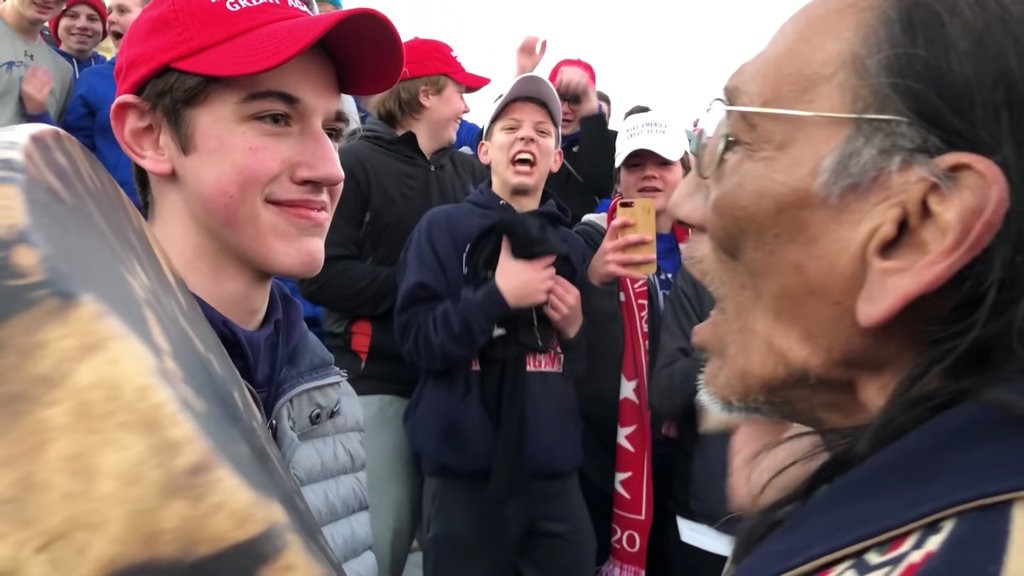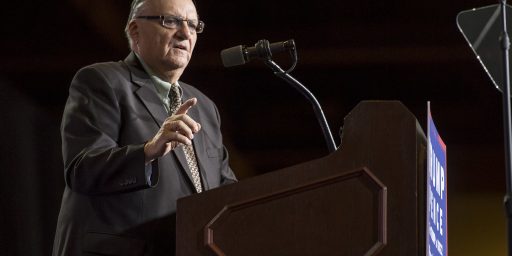Federal Court Dismisses Covington Teen’s Lawsuit Against Washington Post
A Federal Judge has dismissed a defamation lawsuit filed by a Kentucky teenager alleging he had been defamed by the coverage of his confrontation with a Native American man in January.

A Federal District Court Judge in Kentucky has dismissed a lawsuit filed by the parents of a Covington, Kentucky teenager who alleged that the Washington Post had defamed him in its reporting on an incident that occurred in January in which the teenager appeared to have some sort of confrontation with a Native American man leading a protest against the Trump Administration near the Lincoln Memorial:
A federal judge in Kentucky on Friday dismissed a $250 million libel suit against The Washington Post brought by a high school student who claimed that the organization’s coverage of his and his fellow students’ encounter with an American Indian activist at the Lincoln Memorial in January was false and defamatory.
U.S. District Judge William O. Bertelsman ruled that seven Post articles and three of its tweets bearing on Nicholas Sandmann — who was part of a group of Catholic students from Kentucky who came to Washington to march against abortion — were protected by the First Amendment. In analyzing the 33 statements over which Sandmann sued, the judge found none of them defamatory; instead, the vast majority constituted opinion, he said.
“Few principles of law are as well-established as the rule that statements of opinion are not actionable in libel actions,” Bertelsman wrote, adding that the rule is based on First Amendment guarantees of freedom of speech. “The statements that Sandmann challenges constitute protected opinions that may not form the basis for a defamation claim.”
Sandmann’s parents, who brought the suit on their son’s behalf, said they would appeal. “I believe fighting for justice for my son and family is of vital national importance,” Ted Sandmann said in a statement. “If what was done to Nicholas is not legally actionable, then no one is safe.”
The Post, in its motion to dismiss the suit, asserted that its stories were accurate and did not impugn the reputation of Sandmann, a Covington Catholic High School student who entered a social media maelstrom after video footage shot during a chaotic afternoon on the Mall showed him standing face-to-face with drumbeating Indian elder Nathan Phillips.
In his suit, Nicholas Sandmann claimed that the “gist” of The Post’s first article, on Jan. 19, was that he “assaulted” or “physically intimidated Phillips” and “engaged in racist conduct” and taunts.
“But,” the judge wrote, “this is not supported by the plain language in the article, which states no such thing.”
When the videos went viral, showing Sandmann and other students wearing “Make America Great Again” hats, commentators saw an opportunity to criticize supporters of President Trump. Many claimed that Sandmann’s and other students’ behavior reflected a disrespect for the Native American elder, who is also a military veteran.
Phillips, who was part of an indigenous people’s march the same day, said in The Post’s first article about the incident that the teen blocked his way as he was trying to reach the top of the Lincoln Memorial’s steps.
Sandmann later said he was just remaining motionless and calm, in hopes of soothing emotions at the scene.
Sandmann’s suit called The Post’s coverage libelous on its face, but the judge’s opinion cited case law noting that statements must be “more than annoying, offensive or embarrassing.” They must expose the allegedly libeled party to public hatred, ridicule and contempt, among other damaging elements.
In seeking dismissal, The Post’s lawyers also noted that several of Sandmann’s complaints stemmed from the articles’ descriptions of the crowd’s behavior in general, not his. The judge, an appointee of President Jimmy Carter, agreed in many cases. “And while unfortunate, it is further irrelevant that Sandmann was scorned on social media,” the judge wrote.
The judge also found no fault with The Post quoting Phillips.
“The court accepts Sandmann’s statement that, when he was standing motionless in the confrontation with Phillips, his intent was to calm the situation and not impede or block anyone,” the judge wrote.“However, Phillips did not see it that way. He concluded that he was being ‘blocked’ and not allowed to ‘retreat.’ He passed these conclusions on to The Post. They may have been erroneous, but . . . they are opinion protected by the First Amendment. And The Post is not liable for publishing these opinions.”
All of this is rooted in an incident that occurred after the annual March for Life in Washington, D.C. in late January. Sandmann, who attends a prominent Catholic High School in northern Kentucky, was among a group of students and others who had traveled to Washington to take part in the march. After the march was over, Sandmann and several of his fellow students were apparently walking around the National Mall when they came across participants in an unrelated march dealing with Native American rights which Nathan Phillips, a Native American rights activist, was participating in. The two groups, one more or less led by Sandmann and his fellow MAGA-hat wearing students and one led by Phillips, came across each other near the Lincoln Memorial. What happened next is where the story gets murky, as noted in the press coverage that James Joyner links to in his post about the incident. Phillips said he believed that Sandmann and his fellow students were attempting to block and intimidate him while Sandmann claimed that Phillips was exaggerating the situation. Whatever happened, the incident, and especially pictures like the one at the top of this post went viral and the story got out of hand. It was the Post’s coverage of that confrontation that posed the basis for Sandmann’s lawsuit.
As a general rule, a Plaintiff seeking to establish defamation, whether in the form of spoken slander or written libel, must prove several key elements. First, they must prove that the statement was false. Second, they must prove that the statement caused the Defendant some measurable harm, although a Plaintiff need not allege or prove actual monetary loss due to defamation but instead claim reputational damage, leaving it to the finder of fact to determine the compensatory value of that damage. Finally, a Plaintiff must establish that the Defendant made the statement without conducting sufficient research to determine whether or not the statement was true. In addition to all of this, though, there is the exception that statements of opinion are generally not considered libelous and that reporting on the statements made by another person to an incident, such as the opinion of the Native American individual involved in this confrontation that he felt as though he was being blocked by Sandmann and his fellow students.
handed down by the Supreme Court in the wake of the Sullivan case. In the first case, Gertz v. Robert Welch Inc. 418 U.S. 323 (1974), the Court held that strict liability is impermissible in defamation cases, meaning that states could not adopt defamation laws that absolved Plaintiffs of the need to allege or prove fault on the part of the Defendant. The case is perhaps more well-known, though, for the statement in Justice Lewis Powell’s majority opinion that “[u]nder the First Amendment, there is no such thing as a false idea. However pernicious an opinion may seem, we depend for its correction not on the conscience of judges and juries, but on the competition of other ideas.” This led many observers at the time to believe that the Court was headed down the road toward establishing a near-complete “opinion privilege” in defamation cases. In Milkovich v. Lorain Journal Co. 497 U.S. 1 (1990), though, Court declined to go that far and instead stated that opinion can be protected under traditional First Amendment principles while still leaving the door open for a potential defamation claim in cases where the opinion strays over into being an assertion of false and defamatory facts.
Several states responded to Milkovich by either adopting an opinion privilege into their laws or their Constitution. There is, however, no such rule or law at the Federal level. Generally speaking, then, the question of when and whether an opinion can be actionable is something that has to be judged on a case-by-case basis. An opinion that is based on no facts whatsoever, or based on “facts” that are provably false and defamatory, for example, can still be considered to be defamatory if the other standards to make out a claim of defamation are met. To pick an example, stating something about a public official that is couched as an opinion but also includes factual allegations are quite simply untrue can still be considered actionable even it if is characterized as an opinion. Additionally, courts have generally held that statements of opinion that cannot reasonably be interpreted as making a factual statement, such as statements that use hyperbole or obvious satire to make a point would negate the idea that the author of the piece in question was seriously stating an actual fact, are not actionable. Finally, the Courts have held that evaluating whether a statement is a pure opinion or not requires the court to consider the context in which the work is presented.
In his opinion, Judge William Bertelsman, who was appointed by President Carter in 1979, served as Chief Judge of the U.S. District Court for the Northern District of Kentucky in the 1990s, and has been on Senior Judge status since 2001, examined each of the statements that form the basis of Sandmann’s lawsuit (which he lists in a helpful appendix at the end of the opinion) and finds them to largely be statements of opinion, either by the reporter on the scene or by others involved in the incident. Bertelsman’s review of each of these statements is far too lengthy to fairly summarize however the opening to that review and his conclusion essentially wraps all those findings up in a few short paragraphs:
The Court must now determine whether Sandmann’s allegations state a viable claim for relief. These are purely questions of law that bear no relation to the degree of public interest in the underlying events or the political motivations that some have attributed to them.
(…)
[A] “defamation claim against a media defendant cannot derive from ‘a statement of opinion relating to matters of public concern [that] does not contain a provably false factual connotation'” unless “the challenged statement connotes actual, objectively verifiable facts.”
(..)
The Court notes that the present motion does not require the Court to address the elements of truth/falsity, publication (which is not disputed), or negligence. At issue are only whether the statements are about Sandmann, whether they are fact or opinion, and whether they are defamatory.
(…)
As the Court explained at the oral argument on this motion, in modern libel law there are many affirmative defenses, even for claims based on defamatory statements. These defenses are calculated to protect defendants, especially the press, from strict liability.
The defense that a statement of opinion is not actionable protects freedom of speech and the press guaranteed by the First Amendment.
The Court accepts Sandmann’s statement that, when he was standing motionless in the confrontation with Phillips, his intent was to calm the situation and not to impede or block anyone.
However, Phillips did not see it that way. He concluded that he was being “blocked” and not allowed to “retreat.” He passed these conclusions on to The Post. They may have been erroneous, but, as discussed above, they are opinion protected by the First Amendment. And The Post is not liable for publishing these opinions, for the reasons discussed in this Opinion.
Based on the law and on the actual basis for Sandmann’s Complaint against the Post, it seems fairly clear that Judge Bertelsman got this decision right. The vast majority of the statements that make up the basis for his claim are based on the opinion of a third-party, specifically the Native American gentlemen involved in the confrontation with Sandmann. That man’s opinions may be incorrect or based on his misinterpretation of the intentions of Sandmann and his classmates, but they are his opinions. More importantly, given the nature of the story, the opinions of the parties that were involved in the incident are a central part of what happened and described what they believed was an essential part of accurately reporting on that day in January. For that reason, the Judge was correct to dismiss the case.
Sandmann’s parents, who filed the suit on his behalf due to the fact that he is underage and therefore can’t file a claim like this on his own, have vowed to appeal the case to the Sixth Circuit Court of Appeals. This is their right, of course, but I do not believe that Court will find much of a legal basis to overturn Judge Bertelsman’s ruling.
Here’s the opinion:
Sandmann v. Washington Post… by Doug Mataconis on Scribd






That’s … not quite accurate. They were at the point where they were told to meet to go home and a group of Black Israelites began yelling at them. They yelled back. Phillips got between them. And the internet exploded over 30 seconds of video without context.
As for the lawsuit, the dismissal is entirely correct. The WaPo was reporting what people said. But apparently random Twitter users don’t have millions you can sue for, so … can’t blame them for trying.
Doug, you are sooo a lawyer. That post was intense. I like it. You have a POV that is detached and analytical and precise.
You used to be a in your face Libertarian (of the GMU type), but you’ve evolved.
BTW, Don’t ignore the stress of multiple daily posts – that is hard work. I know. Either figure out a release or walk away. There is no shame in that.
@de stijl:
I can still get in people’s faces with the best of them you know.
Hayek or Burke?
Please don’t self-identify as “classically liberal”. It’s a douche move, those words.
Look after your mood and health. You’re hoeing a tough row. The type and amount of text you produce can be exhausting.
@Doug Mataconis:
Just want to say #1 I recognize this too, and #2 I appreciate it also.
It helps that I wake up far too early in the morning and get several posts lined to post for the day.
@Doug Mataconis: Heh, you are far more productive with your early hours than I am. Mine generally begin at around 3:30 and consist of sitting on the front porch with the boys, drinking coffee and listening to the nightly serenade. After an hour or more I read the news and the blogs for far too long.